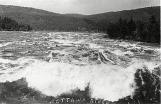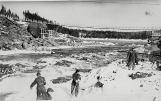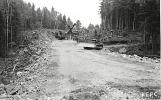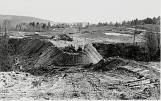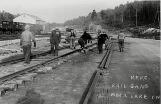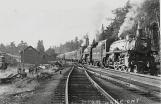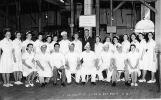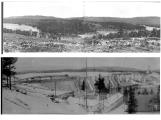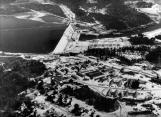

School House Museum
Deep River, Ontario
1
Dam ConstructionMuscle, Rock, Concrete, Wood and Steel
2
This is the story of the taming of the mighty Rapides des Joachims. It tells of the contribution of the 'hands on' workers that turned paper plans into reality. The surveyors, the rock-busters, the nail-drivers, and the concrete-placers that unfolded the gigantic drama of the Des Joachims Power Development.3
Des Joachims Development General Arrangement1946
Des Joachims, Ottawa River, Ontario/Quebec, Canada
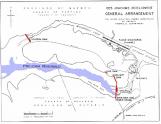
4
This image shows the locations of the 4 dams which had to be built to contain the 130 foot design head of water for the power plant. The image also shows the pre dam riverbed, and the flood discharge channel that had to be blasted from the south east end of McConnell Lake to the Ottawa River close to the village of Des Joachims.6
This image shows the lower rapids east of Des Joachims village in summer of 1945 before construction began.The river was a raging torrent as it roared over the descending rocky river bed at
Des Joachims.
8
This image shows the bridge which is still in use between Ontario and the Quebec village of Des Joachims. Note the small distance between the bridge deck and the water surface. Today the water discharge from the powerhouse flows in the excavated tail race channel a great distance below the bridge deck.10
This image shows the present bridge in the upper left and a bridge that was removed in the upper right.11
Preliminary work on the project started in 1942 but was put on hold early in 1943 due to the requirement for men and materials for the 2nd World War effort.12
Work resumed in 1946 with surveying, clearing and logging operations above the dam site, the building of the new Moor Lake Road, setting up a temporary tent camp and clearing the site for Camp #1. Until the Moor Lake Road and rail siding was available in May 1947 all materials had to be hauled by road from Chalk River Station.14
This image shows a survey crew at work beside the rapids in the winter of 194516
When the project began, Moor Lake C.P.R. Station (Approx. 2 miles south by wagon road) was essentially a passenger stop. All freight had to be transported by truck from the C.P.R. rail yard at Chalk River village. This alternative involved 20 miles of road (mostly highway #17) with a substantial hill on each side of Meilleurs Bay. Upgrading the rail access at Moor Lake Station was a more attractive option. A new road was built between highway #17 and Moor Lake Station and a rail yard with additional sidings and a substantial unloading area was added. This image shows work in progress on the road close to the station18
As with the road to Moor Lake Station, the road to Des Joachims Village was not adequate for heavy equipment traffic loading requirements. So the old Mattawa road which had provided access to the village was replaced with the road still in service in 2004. The photo shows the start of the new road with highway #17 heading east at the top right.Audio Text - Henry Chasse
Harco built the canal - "Harvey", that's Harvey Construction, Harvey Construction built the Swisha Road; Therion Construction built the Moore Lake road, I worked for them too, and Harco dug the canal like I said a while ago and Hydro did the other one. Atlas built the dam at McConnel Lake, a lot of other contractors in the area but I dont remember what they did.
20
Workers are shown adding sidings to expand the rail yard at Moor Lake Station22
A "Double Header" C.P.R. passenger train is shown passing through Moor Lake Station on the main line in 1947. The completed siding tracks installed during the expansion of the Moor Lake rail yard can be seen in the centre of the image with Moor Lake Station building to the left of centre23
1946 and 1947Actual construction began in the fall of 1946 with a small staff and modest infrastructure. 1947 saw a rapid expansion of staff, infrastructure and construction activity. The tent camp gave way to more comfortable lodging in bunk houses and the cafeteria at camp #1 opened for business. A cofferdam was installed across the Ontario channel and form work on the main dam began. Assembly of the Ontario and Quebec concrete mixing plants got underway but rock excavation at the main dam was the priority.
24
A cofferdam was installed across the Ontario channel and form work on the main dam began. Assembly of the Ontario and Quebec concrete mixing plants got underway but rock excavation at the main dam was the priority.26
The opening of the Camp #1 Cafeteria was welcomed by the hungry construction troops. The smoke above the roof of the building is said to be the chef burning the toast.Audio Text - "Q" - J Wright - "A"- Henry Chasse
Q.There were three cafeterias, were they all roughly the same size?
A. Ya, pretty well - ya, like this one would seat 400 people and then there was
one - heck - a stones throw from - there was two of them. The other one was used more
from the Construction, "Harco", that did the canal - they were open 24 hours a day. And
they had one at Swisha the same as that and one at McConnell Lake.
28
It's an old rule on construction jobs that men only work as well as they are fed. And at camp No.1 Rosaire "Rockey" Savard of Dolbeau, Que., wears his white chef's hat like a crown. A former ship's cook he and his five cooks, two butchers, two bakers, two pantrymen and 13 waitresses have dished up 2,500 meals in one day. At one record meal 1,050 diners passed through the cookhouse in 45 minutes.30
The Cafeteria menu for dinner on Sunday 30 November 1947. It may not be the Hilton but the food was good and wholesome and there was lots of it.32
Newly opened bunk houses provided warm, comfortable accommodation. A welcome improvement over the tent camp in use during the winter of 1946.Audio Text - "Q" - J.Wright. "A" - Henry Chasse
Q. How many men would be in a bunkhouse?
A. About 80, ya, I think these were "H" style, that center thing is all bathrooms and toilets and there's 40 men on each side.
Q. Double Bunks or single?
A. At that time that's all double bunks.
34
The first cofferdam being installed between the Ontario shore and the island. Cofferdams are used to block water flow when it is necessary to work in a dry situation. Once the cofferdam is sealed in place, pumps are used to dewater the area35
A cat scraper being loaded onto the Hydro barge below the dam1947
Des Joachims, Ottawa River, Ontario/Quebec, Canada

36
Heavy equipment was transported across the river when cofferdams or bridges were not available. Here a CAT hauled scraper is loaded onto a barge.38
Image shows rock removal for base of the Main Dam. View is from the river bed toward the Ontario side. Levels are being established for the formwork. The Ontario concrete mixer can be seen at top centre.40
Work on the base of the main dam is shown. The concrete mixer on the Quebec side can be seen to the right of centre just below the cableway tower. The main anchor cable for the cableway tower can be seen angling down behind the tower.42
The completed Concrete mixing plant on the Ontario side is shown here. The 3 concrete mixing plants on this project supplied the total 890,000 cubic yards of concrete required to build the Des Joachims structures.43
The construction of a power station the size of the Des Joachims plant would be no mean task if the site was dry land. Such was of course not the case in the midst of the Ottawa River. Dry land can be achieved and was achieved in the Ottawa River by the use of cofferdams to hold back the water and pumps to dewater the work area.However, the average water flow in the Ottawa River at Des Joachims is ~ 30,000 cubic feet per second and this water can't be stopped flowing for 4 years but it can be diverted to another route. So, for the life of the construction project an alternate channel had to be provided at all times to allow the work to proceed. Major juggling was required to advance the project while providing a flowpath for the river. Some of the images that follow will show the various river diversions in use.
44
Work progress reached full speed in 1948:Atlas Construction Company started work on the McConnell Lake Control Dam.
Work on the main Conveyer Bridge began.
In March the first concrete was poured in the fabrication of the Main Dam.
The Cableway was completed and placed in service.
Bell Lake and McConnell Lake stone crushers were placed in service.
One section of the Conveyor Bridge collapsed killing 6 riggers.
The Rolphton Primary School was opened in September.
In December the Quebec Concrete Mixing Plant was placed in service.
The river was diverted back into the old Ontario channel.
46
The McConnell Lake Control Dam, which is shown more than half completed in this image, was started by Atlas Construction Company. This dam is required to spill excess water that cannot be passed through the turbines in the power house. This situation arises in the spring of the year when the normal river flow, augmented by melting snow, exceeds the capacity of the power plant turbines. Most of the year the Control Dam gates are closed and there is no water flow through dam.48
The conveyor bridge shown in this image (running from top left to centre) supported a conveyor belt that carried the concrete from the mixing plant and delivered it to the forms of the Main Dam. The mixing plant can be seen in the centre of the image below and behind the Cableway Tower. The Conveyor bridge construction was begun early in the year and the first concrete poured into the forms of the main dam in March1948.49
Looking from the Ontario side at the frame (form) work1948
Des Joachims, Ottawa River, Ontario/Quebec, Canada

50
This image is primarily of the progress with the main dam concrete but it also provides a good look at the cableway with its load suspended from the cable midway across the river. The cableway which went into service during the summer of 1948 was erected to help construct temporary Bailey bridging across the river, to simplify the installation of the powerhouse and to act as a general carrier during dam construction.52
The crushers at Bell Lake and McConnell Lake both went into service in 1948. These crushers supplied aggregate to the concrete mixing plants. This image shows a Euclid truck unloading rock into the crusher at McConnell Lake pit.Audio Text - Henry Chasse
You see, we were doing the same thing at Bell Lake as you see there. We were
hauling it - see a dragline was loading us, there was two of us up there all the time
hauling steady eh into the crusher - like 35 ton loads at a time and then it was crushed
and belted to Hyro at the dam - their mixer on the Quebec side that is.
53
The conveyor belt crossing the road to the McConnell lake control dam1948
Des Joachims, Ottawa River, Ontario/Quebec, Canada

54
Part of a network of conveyor systems on the project. This conveyor carried aggregate from the crusher at Bell Lake to the aggregate storage area which supplied the mixing plant on the Quebec side of the Main Dam. Note the van on the road crossing under the conveyor.Audio Text - Henry Chasse
Just before you get to the sawmill there's a road in to the right - Papineau's Camps - this is where the crusher was set up and the belts ran from there to the main dam.
55
As the steel work progressed towards the Quebec side, a section between two towers fell1948
Des Joachims, Ottawa River, Ontario/Quebec, Canada

56
Concrete placement was going well, with some fifty thousand cubic yards placed in the Main Dam and approximately one thousand in the Power House when a major disaster struck the project. A section of the high level Bailey Conveyor Bridge collapsed killing six riggers. The loss of these men was a severe blow to the close knit work force.The image shows the missing horizontal section of the Bailey bridge lying twisted on the rocks at the base of the tower at the right.
Audio Text - Earl Ruhnke
That was a bad day! - - that was a terrible day - - the whistles were blowing, and they said , "come on down and help us look for those guys". I knew them all, I knew Jetty, I knew most of the guys from Pembroke, He was a mute and he was the only one that wasn't still tied on. He knew, I guess, they were falling and he was a good swimmer, and they saw him swimming down but they never did find him. The guys that were tied on, they were still attached to the bridge.
Ya, that was right near quitting time eh, That was the last section, Right over the fast
Water
Audio Text- Henry Chasse
I was at the mill and that's the road over there that comes from the mill towards
the camp and I was about here just on the hill and I heard that CRASH!, the worst sound
I ever heard, and I looked back and I couldn't tell what it was really because I - the span
didn't look like really - It looked like it had never been there but then you could hear the
people shouting.
58
Rolphton Public School is pictured here. The public school, built in the colony, was opened for business in time for the start of school in September 1948. The school was built with 3 classrooms but the capacity was doubled before the project was completed.59
A front view of the mixer nearing it's completion1948
Des Joachims, Ottawa River, Ontario/Quebec, Canada

60
The Concrete Mixer on the Quebec side went into service in December 1948. This picture shows the mixing plant nearing completion. The fully automated plant has four cement storage silos and four 2 cubic yard mixers.Audio Text - Henry Chasse
I used to haul a lot of stuff out of there, ya - they used to use Euclids, I'll show you
the next time you see a Euclid, you see the back of the box slopes up like that eh - and
they used to add I believe it was an 8 inch plank - hardwood plank to bring it up to water
level, and thats the way they used to haul it - wet cement - water level - and it was hard
to drive eh - you're going like this and like that eh - but ya, that's the way they hauled it and
you had to go from there to McConnell Lake and if you were held up at all, any amount
of time, you'd dump your cement along the side of the road and you can still see cement
along the side of the road yet. Truck loads, there'd be 11 yards - be somthing like 15 tons
of cement at a time - what a waste!
62
Toward the end of the year emphasis was placed on completion of the temporary Sluiceway located at the Ontario end of the Main Dam. Just before Christmas 1948 the temporary Sluiceway was placed in service allowing diversion of the river to flow in the old Ontario Channel. This in turn permitted work on the cofferdam to close off water flow in the Interprovincial Channel. The image provides a close-up view of the river flowing through the temporary sluiceway at the Ontario end of the Main Dam. The steel framework of the Powerhouse can be seen at centre right. The cableway can be seen in operation with its load suspended above the Powerhouse framework. (Those with good eyesight should be able to see the cable angling downward from the tower toward the load and rising again leaving the load as it exits the picture at the right).63
As 1949 began, the Construction force had grown to 2400 men and women working as a highly coordinated organization.Cofferdams blocked the Interprovincial Channel and dewatering was achieved after some persistent leaks were stopped.
Headworks transition and Draft tube forms were built.
By the spring of 1949 significant progress had been made on the McConnell Lake Control Dam and the temporary Sluiceways at that location were partially completed.
Work began on the Auxiliary Dam.
By summer things were really coming together; Penstock erection was underway, and the Powerhouse permanent bridge cranes were installed.
The gantry crane and specially designed closure gates were erected on the Main Dam permitting closure of the Main Dam to begin in July.
In August, McConnell Lake Control Dam spilled the first upper Ottawa River water into McConnell Lake and on into the lower river through a new channel at the east end of the lake.
In September the lower end of the Ontario channel was cofferdammed and excavation of the tailrace channel began.
64
Work began on the Auxiliary Dam.By summer things were really coming together; Penstock erection was underway, and the Powerhouse permanent bridge cranes were installed.
The gantry crane and specially designed closure gates were erected on the Main Dam permitting closure of the Main Dam to begin in July.
In August, McConnell Lake Control Dam spilled the first upper Ottawa River water into McConnell Lake and on into the lower river through a new channel at the east end of the lake.
In September the lower end of the Ontario channel was cofferdammed and excavation of the tailrace channel began.
66
The Construction work force peaked in 1949 at or near 2400 employees. This view over the site, looking west from the current lookout on highway #17 confirms the expanse of the Project. The sign on the north side of the highway announces the TRAFFIC SIGNAL 1000 FEET AHEAD at the intersection of highway #17 and the Moor Lake Station Road to the south and the road to the village of Des Joachims to the north.68
Wooden forms were made to shape the concrete transition to the penstock from the headworks and also the draft tube which directs the water exhausted from the turbine out into the tailrace. These transitions are also known as flumes. This picture shows a draft tube transition form nearing completion beside the carpenter shop.69
The "tailrace section" or outlet "flume frames (forms)" set in the concrete1948
Des Joachims, Ottawa River, Ontario/Quebec, Canada

70
Two draft tube forms (ref. previous image ) are shown set in place in depressions hewn from the bedrock. The forms are then encased in concrete. When the concrete has cured the forms are dismantled and the wood removed leaving the shape of the form in concrete.71
The inlet of the "scroll case" section of a flume1948
Des Joachims, Ottawa River, Ontario/Quebec, Canada

72
The 'scroll case' is shown with the large circular opening in the foreground. The scroll case is shown oriented horizontally as it will be installed above the draft tube (ref. previous image ). The large opening is the inlet of the scroll case. The inlet is connected to the lower end of the penstock (or large pipe) which feeds water from the upper level of the dam (ref. next image ). The function of the scroll case is to equalize inlet water pressure around the turbine and provide radial inlet water flow to the turbine runner.74
Here all 8 units are shown in progressive stages of completion from left to right. The components shown in the 3 previous images are shown here as installed. The units are numbered from left to right; unit 6 transition or flume form shown ready to be connected to the penstock (or large angled pipe). Units 1, 2 and 7 have forms in place ready for pouring the concrete to encase the headworks transition or flume. Unit 6 provides a good view of the installed scroll case (bottom centre of image); note the large circular opening in the top centre of the scroll case where the turbine runner (water wheel) will be installed (ref. next image ).76
A 'Francis Turbine Runner' is shown on its shipping crib. The runner is to be installed in the centre of the scroll case. The runner is shown here on its side. Installation would require tipping the runner trough 90 degrees toward the viewer. The scroll case provides radial inflow of water at the circumference of the runner. The force of the water, changing direction as it flows through the runner, causes the runner to rotate the generator shaft that is connected to it. Water which has given up its energy leaves the runner via the centrally located draft tube to the tailrace.78
By summer 1949 McConnell Lake Control Dam was nearing completion as shown in this photo. Work on the Auxiliary Dam across the Interprovincial Channel was also underway80
Summer saw penstock erection nearing completion. The penstocks are the large diameter steel pipes shown angling down from the top of the Main Dam in this picture.In the Powerhouse, work on the steel superstructure continued and the permanent bridge cranes were installed
82
In July'49 the gantry crane and special closure gates were erected on the Main Dam permitting the closure of the temporary sluiceways to begin. The crane can be seen on the top of dam in the centre of the image. The tops of the steel gates can be seen above the surface of the water in the 2nd, 3rd and 4th sluiceways from the left. Once the closure gates are in place, concrete is poured behind them to conform with the solid section of the dam already in place. On 26th August McConnell Lake Dam spilled the first Upper Ottawa River water into McConnell Lake. From the east end of the lake, water flowed through a new channel and on into the lower river on the north side of Des Joachims village.Main Dam closure was completed on the 15th September 1949.
Audio Text - Morris Barr
The Gantry Crane - we used it on the Ontario side for to put in the Sluce Gates and they'd pour concrete behind it and we'd take the gates out and move them over and put them in again, in betwean the piers. They'd just pour so much in each one and keep raising the water like. Then when we finished on the Ontario side, we tore it all down and moved it over to McConnell Lake and done the same thing over there.
83
The tailrace area viewed looking upstream towards the dam from the "Swisha" bridge1950
Des Joachims, Ottawa River, Ontario/Quebec, Canada

84
Once the Main Dam was closed, the tailrace outlet to the Ottawa River was blocked with a cofferdam. Pools of water remaining in the path of the tailrace were pumped out and the work of removing some 1.5 million cubic yards of rock began. The image shows the tailrace channel nearing completion. This photograph was taken from the Des Joachims bridge looking upstream in April 1950.Audio Text - Henry Chasse
Hydro built to the coner, see, where it makes a curve. Hydro built from the Dam
to that - or excavated from the Dam to that and Harco Construction from the river below
the bridge to - they met on the curve. Harco Construction camps were right at the
bridge. You probably have been there, the cement slabs are still there. They had a big
outfit too - a big outfit!
85
1950As the New Year 1950 was rung in, the race for the finish of the project was on!
Once the Powerhouse structure was erected for units 1 and 2, the building was closed in and the turbines and generators installed. This process of building steel, then cladding, then turbine, then generator continued to grow the Powerhouse along the base of the dam until all eight units were in place.
The 230KV Switchyard, providing the link from the generators in the Powerhouse to the Ontario Hydro Transmission Grid, was pushed to completion in the spring of the year.
In concert with the myriad of activities in the Powerhouse and Switchyard, completion of the Main Dam Headworks and final closure at the McConnell Lake Control Dam was accomplished.
All of the project activities over the preceding 4 years contributed to the delivery of first power to the grid in the summer of 1950. The Project was completed in the winter of 1950.
86
In concert with the myriad of activities in the Powerhouse and Switchyard, completion of the Main Dam Headworks and final closure at the McConnell Lake Control Dam was accomplished.All of the project activities over the preceding 4 years contributed to the delivery of first power to the grid in the summer of 1950. The Project was completed in the winter of 1950.
88
These composite photos taken from a common location provide an interesting Before and After comparison. The wild energy of the rapids above is in the process of being captured by the emerging power plant below.90
An aerial view of the Des Joachims development, showing the completed plant. The main dam, spanning the Ottawa River for a distance of 2, 400 feet, rises to a maximum height of 190 feet above sound rock. Construction camp #1 and other construction related equipment have yet to be removed from the site.92
An aerial view McConnell Lake Control Dam, where final closure of the Ottawa River will be made. Situated in Quebec, 31/2 miles from the Main Dam, the 1600 foot long structure spans the deep basin lying between the western end of McConnell Lake and the main stream of the Ottawa River.93
Construction EpilogueAnd so it came to pass in the warm days of 1950, that the Rapides des Joachims began to deliver up their energy to the people of Ontario.
Much has already been written and more will surely be written on the engineering aspects of this great Development.
But let us always remember the men and women whose hands, whose arts and crafts, and whose lives forged and created this engineering monument of steel and concrete. Together they make up the team that built Des Joachims, and it is their work that will bring better living to the people of Ontario.
